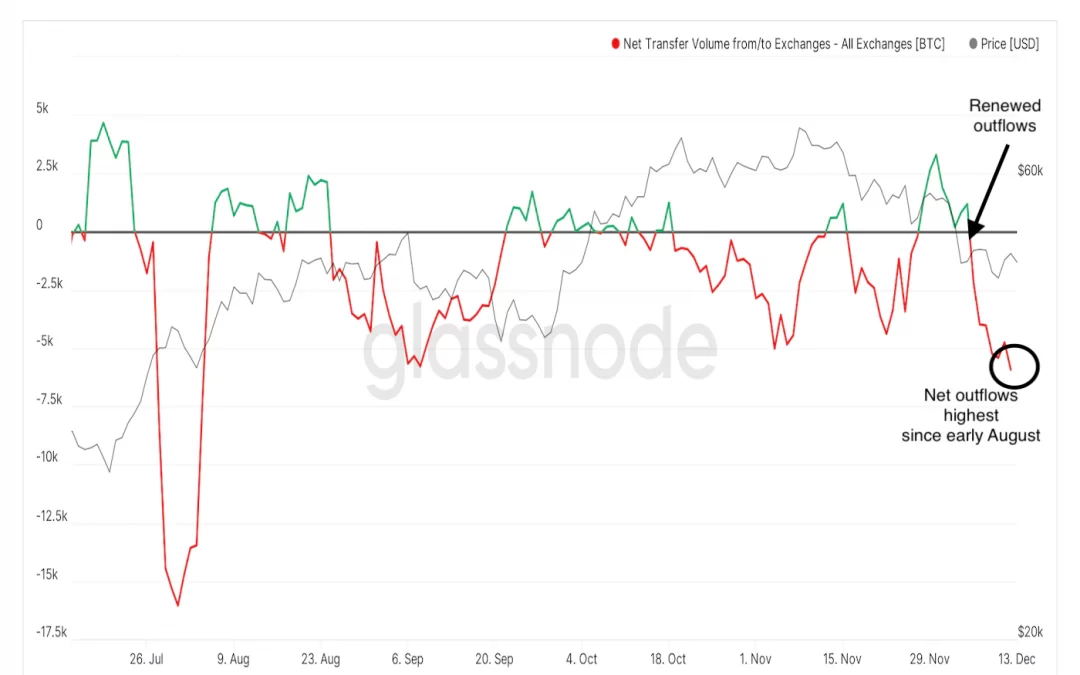Crypto investors appear to have resumed bitcoin accumulation, a sign they expect the price to rise, after U.S. stock markets overcame concerns about the economy to post their strongest gains in 10 months last week.
Blockchain data tracked by Glassnode shows the seven-day moving average of exchange flows turned negative a week ago, indicating net outflows. The level fell to -5,924 BTC on Sunday – the lowest reading since early August. According to IntoTheBlock, coins worth $3 billion left centralized exchanges last week, the biggest weekly outflow in five months.
Investors typically take direct custody of coins when anticipating a price rise. A continued exodus of cryptocurrency from exchanges implies less selling pressure in the market and scope for a sharp rally.
“Crypto going into exchanges may signal selling pressure, while withdrawals potentially point to accumulation,” Lucas Outumoru, an IntoTheBlock research analyst, said in a weekly research note published Friday.
The S&P 500 and the Nasdaq Composite rose 3.8% and 3.6% last week, their biggest weekly ascents since early February, even as a report showed U.S. inflation climbed to a four-decade high in November, sealing the deal for a faster unwinding of the crisis-era stimulus by the Federal Reserve (Fed). The Dow snapped a four-week losing trend with a 4% rally and bitcoin ended a three-week losing trend, adding 1.2%.
Renewed accumulation amid risk reset in traditional markets perhaps reflects investor confidence that much of the bad news has been priced in and the path of least resistance is to the higher side.
Risk assets took a beating in the second half of November and early this month on the emergence of the new omicron coronavirus variant and Federal Reserve Chairman Jerome Powell’s hawkish turn.
The bar for a hawkish surprise is set high
The Fed will hold its two-day meeting on Dec. 14 and 15. The central bank is expected to bring forward the timeline for the end of monthly bond purchases to March 2022 from mid-2022, and signal that it expects to start raising rates next year.
Fed fund futures appear well ahead of the curve, having already priced in a 25 basis point interest-rate increase in May. Further, rates markets are pricing in a 91% probability of five 25 basis point rises over the next two years.
Thus, the bar for a hawkish [anti-stimulus] surprise appears to have been set relatively high. Bitcoin and asset prices, in general, could remain resilient unless the central bank hints at more aggressive tightening than is anticipated.
“We know the Fed is going to maintain their hawkish stance given last week’s inflation numbers, but the critical question is to what extent. We will not be expecting any major surprise as most analysts are aligned towards a faster pace of tapering,” said Lennard Neo, head of research at Stack Funds.
“Traditional markets have shown some resilience the past few days, and this should reduce further downside strain on the crypto markets, at least in the near term,” Neo said.
In all, there are 17 central bank meetings this week, including decisions from the Fed, Bank of England (BOE), European Central Bank (ECB), and Bank of Japan (BOJ).
The BOE will likely push out the first interest rate hike to 2022, Bloomberg reported. According to Marc Chandler, the chief market strategist at Bannockburn Global Forex, the BOJ is likely to be a non-event, and the ECB is less worried about inflation than its American counterpart and is unlikely to deliver a hawkish surprise.














